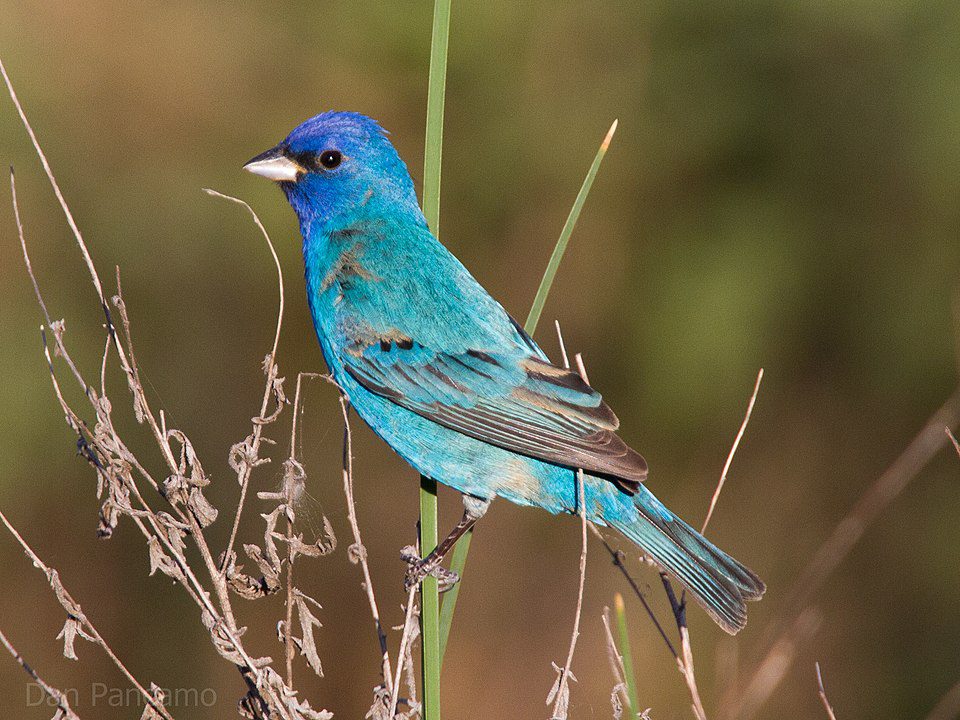Unveiling the Titans: Meet the World’s Biggest and Most Impressive Snakes!
Welcome to our exploration of the biggest snakes worldwide, where we delve into the fascinating world of these remarkable reptiles. Do you know which species reign as the largest of all snakes worldwide?
In this blog post, we’ll introduce you to venomous giants such as Africa’s Black Mamba and Southeast Asia’s King Cobra, known for their impressive length and potent venom. We will also discuss massive pythons like the Reticulated Python and Burmese Python that can grow to incredible lengths.
Our journey through the realm of the biggest snakes worldwide doesn’t stop there; we’ll venture back in time to examine prehistoric Titanoboa fossils that reveal their astounding size. Finally, we’ll explore North American giants like Eastern Diamondback Rattlesnakes and African-Australian behemoths such as African Rock Pythons and Amethystine Scrub Pythons.
Prepare yourself for an enthralling experience with these magnificent creatures as we uncover their secrets together.
Venomous Giants
Some of the world’s largest serpents possess deadly toxins, creating a dangerous situation for both people and other creatures. These slithery giants can grow up to 14 feet long and have toxic venoms that can cause death within minutes if not treated with antivenom. In this section, we will explore two of these massive venomous snakes – the Black Mamba and the King Cobra.
Black Mamba: Africa’s Largest Venomous Snake

The Black Mamba, native to sub-Saharan Africa, is known for its agility, speed (reaching speeds up to 12 mph), and potent neurotoxic venom. Measuring between 8-14 feet in length on average, it is considered one of the deadliest snakes worldwide due to its aggressive nature when cornered or threatened.
The bite from a Black Mamba can be fatal without immediate medical attention; symptoms include rapid onset muscle paralysis followed by respiratory failure.
Diet & Habitat:
- Diet: Birds, small mammals like rodents & squirrels.
- Habitat: Savannahs, grasslands & rocky hillsides across eastern & southern Africa.
King Cobra: One Of The Longest Venomous Snakes
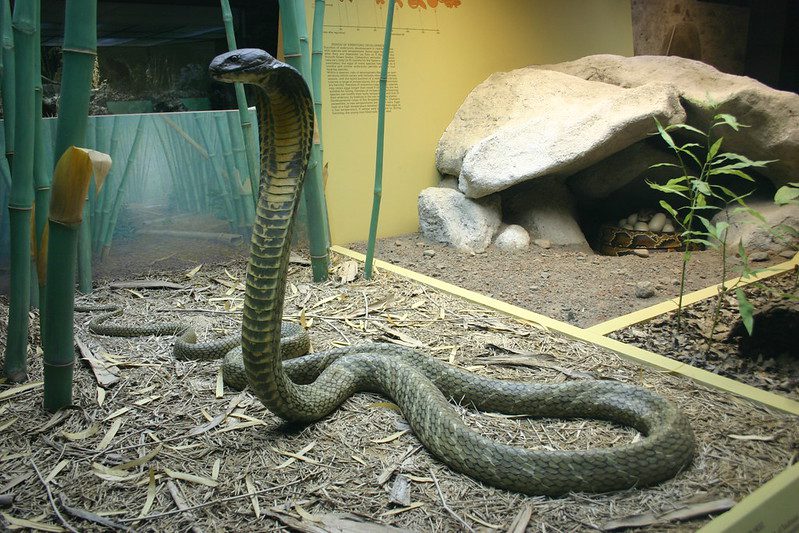
The majestic King Cobra, found predominantly in Southeast Asia’s dense rainforests and plains regions, holds the title of one of the longest venomous snakes globally, reaching lengths of up to 18 feet. The King Cobra’s potent neurotoxic venom can cause paralysis and death within minutes if not treated with antivenom promptly.
Diet & Habitat:
- Diet: Primarily other snakes, but also small mammals and birds occasionally.
- Habitat: Dense rainforests, bamboo thickets & mangrove swamps across Southeast Asia.
In this diverse world filled with fascinating creatures, it is essential for nature lovers to be aware of these magnificent yet dangerous reptiles. While they pose a significant threat when encountered in their natural habitats or accidentally stumbled upon by humans, understanding their behavior and characteristics can help us appreciate them from a safe distance as part of our planet’s incredible biodiversity.
The venomous giants of the world can be both awe-inspiring and dangerous. Moving on to massive pythons, these creatures have their own set of characteristics that make them unique from other snake species.
Massive Pythons
Pythons are known for their immense size, with some species growing up to 28.5 feet long and weighing as much as 145 kilograms. These nonvenomous constrictors feed on various prey ranging from small mammals to large ungulates, using their powerful bodies to suffocate their victims before swallowing them whole.
Reticulated Python: The longest recorded python species
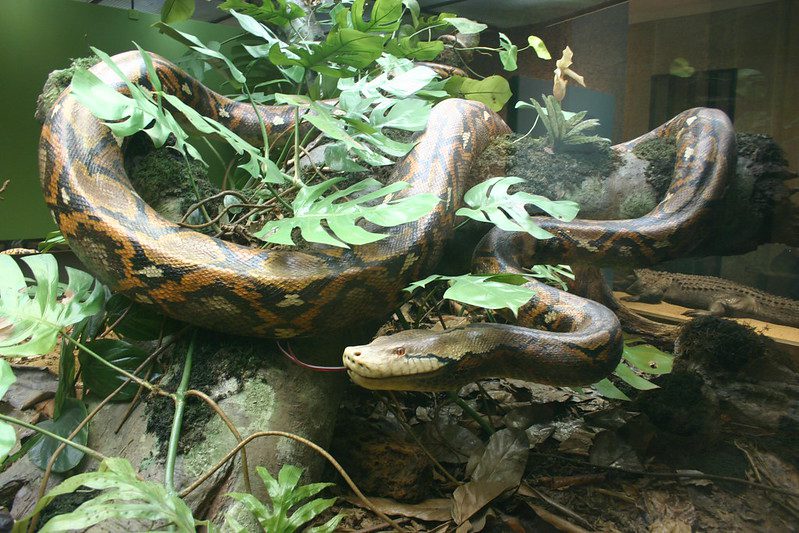
The Reticulated Python (Python reticulatus), native to Southeast Asia, holds the record for being the longest snake in the world. A specimen named Medusa, housed at a natural history museum in Kansas City, measures an incredible 25 feet and two inches long. Reticulated pythons are not only famous for their huge size but also for their striking geometric patterns that provide excellent camouflage in dense foliage.
- Average Length: 10-20 feet
- Maximum Recorded Length: Over 28 feet (8.7 meters)
- Diet: Mammals such as rodents and primates, occasionally birds or reptiles
- Habitat: Rainforests, woodlands, and grasslands of Southeast Asia
Burmese Python: A native of South Asia’s grassy marshes

The Burmese Python (Python bivittatus) is another giant among snakes that can grow up to a staggering length of more than twenty-three feet while weighing over ninety kilograms, making it one of the heaviest snake species. Invasive in Florida’s Everglades National Park, the Burmese Python is a native of South Asia with an average length of 12-19 feet and a maximum recorded length of over 23 feet (7 meters).
- Average Length: 12-19 feet
- Maximum Recorded Length: Over 23 feet (7 meters)
- Diet: Birds and mammals such as rodents, rabbits, and deer
- Habitat: Grassy marshes and swamps of Southeast Asia; invasive in Florida Everglades
In addition to these two massive pythons, other large python species include the Indian Python (Python molurus,) which can grow up to nineteen feet long. Snake aficionados are consistently enthralled by the immense magnitude and power of these extraordinary creatures, which still captivate scientists globally.
Massive Pythons are one of the most impressive reptiles in the world, with some species reaching lengths up to 25 feet. Their remarkable size and strength demonstrate their evolutionary success, making them an interesting subject for further research. Now let’s take a look at another massive reptile that lived millions of years ago: Prehistoric Titanoboa.
Prehistoric Titanoboa
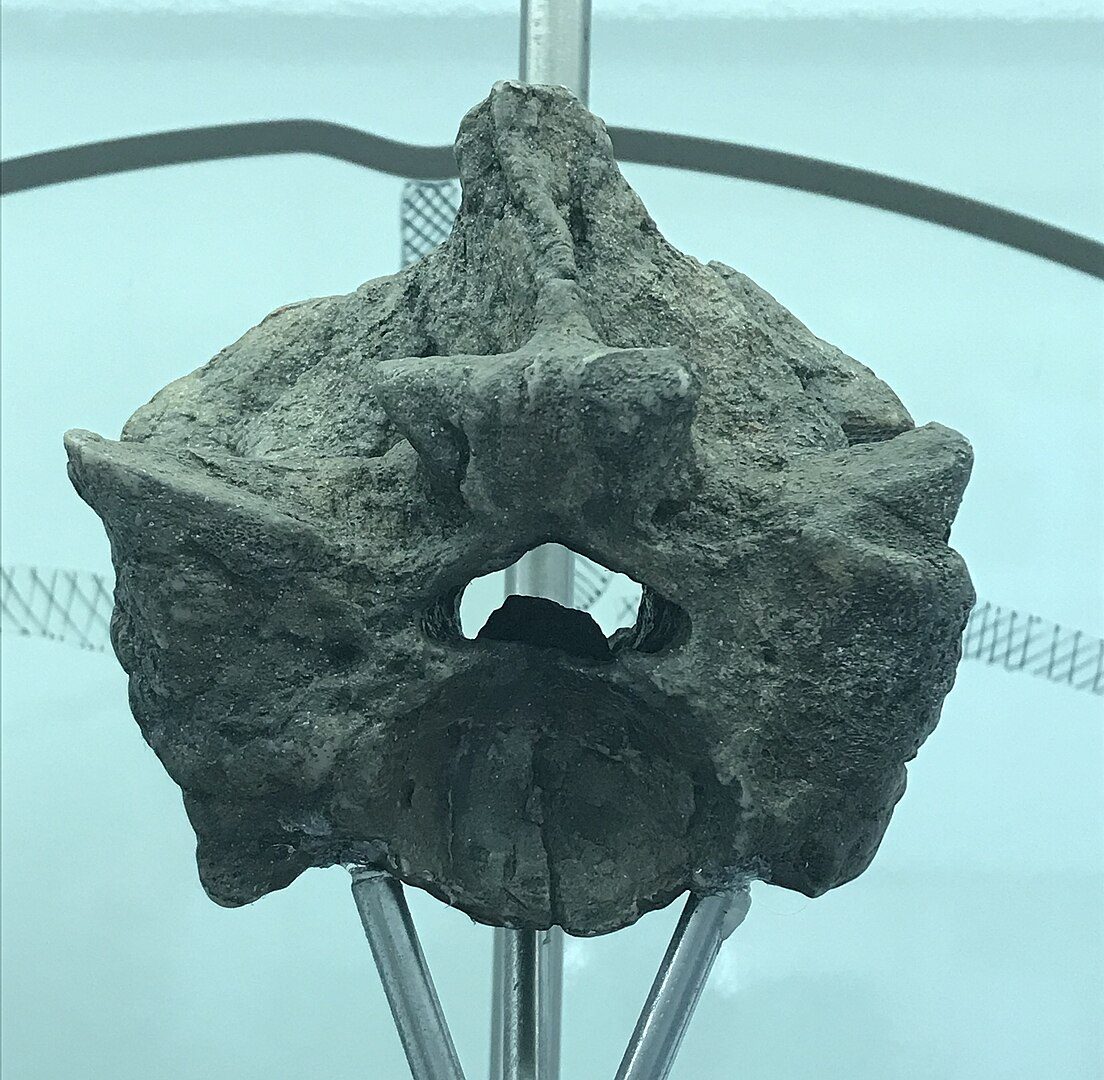
The Titanoboa was an ancient serpent that lived around 60 million years ago during a time when Earth’s climate was warmer than previously thought. This supersized anaconda-like creature measured an astonishing 42 feet in length and weighed approximately 1.5 tons, making it one of the most massive snakes ever discovered.
Fossil evidence reveals its incredible size.
Discovered in Colombia’s Cerrejon coal mine, the fossil remains of this colossal snake have provided scientists with valuable insights into its anatomy and lifestyle. The sheer magnitude of the fossils reveals that Titanoboa must have been a powerful hunter, able to take down large animals such as crocs and turtles.
Researchers believe that due to its immense size, Titanoboa relied on ambush tactics to capture unsuspecting victims rather than actively pursuing them as modern-day constrictors do. To learn more about the fascinating discovery process behind unearthing this prehistoric giant, check out this Smithsonian article.
Tropical habitat supported this colossal predator.
The warm climate conditions during the Paleocene epoch allowed for lush tropical rainforests to flourish across South America – providing ample resources for gigantic reptiles like Titanoboa to thrive.
These dense forests offered plenty of hiding spots for these enormous snakes while also supporting a diverse range of potential prey species which could sustain their voracious appetites.
- Paleocene Epoch: A period spanning from roughly 66 million years ago until around 56 million years ago characterized by warm global temperatures and abundant plant life.
- Tropical Rainforests: Rich, biodiverse ecosystems that receive high amounts of rainfall and support a wide variety of plant and animal species.
By studying the remains of Titanoboa and its environment, scientists have gained valuable insights into Earth’s prehistoric climate conditions. For more information on how these ancient habitats supported such enormous creatures, take a look at this National Geographic article.
The Prehistoric Titanoboa was a giant predator that dominated its tropical habitat, and though it is no longer around today, the evidence of its existence still remains. Moving on to North American Snakes, we will explore some of the largest species living in this region.
North American Snakes
The Eastern Diamondback Rattlesnake is considered one of the most dangerous venomous snakes found in North America due primarily to its potent double-action venom containing crotalase enzyme, which can cause severe damage upon envenomation. However, readily available antivenin has mitigated fatalities caused by these encounters.
Eastern Diamondback Rattlesnake: World’s heaviest poisonous snake
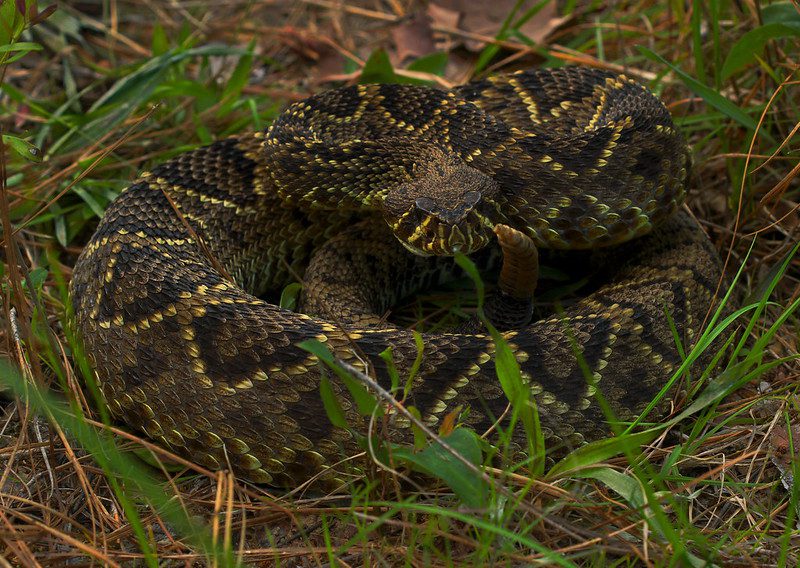
The Eastern Diamondback Rattlesnake (Crotalus adamanteus) holds the title of being the world’s heaviest venomous snake, with some specimens weighing up to 15 kilograms (33 pounds). They are native to the southeastern United States and prefer habitats such as pine forests, palmetto flatwoods, and coastal marshes.
The Eastern Diamondback Rattlesnake is easily recognizable by its diamond-shaped pattern on the back, providing camouflage in its natural habitat. The Eastern Diamondback’s diet consists mainly of small mammals like rabbits and rodents but may also include birds or even other snakes. Learn more about this fascinating species from National Geographic.
The potential danger posed towards humans.
While Eastern Diamondbacks are not known for being aggressive towards humans unless provoked or threatened, they still pose a significant risk due to their highly toxic venom. A bite from an Eastern Diamondback can lead to symptoms such as extreme pain, swelling at the site of the bite, difficulty breathing, vomiting, low blood pressure, kidney failure and potentially death if left untreated.
Fortunately, the Centers for Disease Control and Prevention (CDC) states that fatalities from venomous snake bites in the United States are rare, thanks to effective antivenom treatments and prompt medical care. Be mindful when outside, particularly in spots where these serpents are known to exist, as a way of reducing the risk of coming across an Eastern Diamondback.
- Avoid tall grass or brush: Snakes often hide in these areas while waiting for prey or seeking shelter from predators.
- Wear protective clothing: Long pants and boots can help protect against snakebites if you accidentally step on or near a hidden snake.
- Be cautious around rocks and logs: These can serve as hiding spots for snakes, so use caution when moving them or stepping over them.
In case of an encounter with an Eastern Diamondback Rattlesnake or any other venomous species, it’s crucial to remain calm and back away slowly without making sudden movements.
If bitten by a venomous snake, seek immediate medical attention, keep the affected limb immobilized at heart level, and remove tight clothing or jewellery near the bite site but avoid trying to suck out the venom or applying ice as this may worsen symptoms instead of helping alleviate them.
Remember that education about local wildlife and taking necessary precautions is key to safely coexisting with these remarkable creatures.
In contrast to the relatively diminutive North American species, African and Australian snakes are colossal in comparison. With their heat-sensing pits aiding them in nighttime hunting, African Rock Pythons and Amethystine Scrub Pythons pose an even greater danger towards humans than North American Snakes do.
African and Australian Giants
Among the largest snake species in the world, we find two remarkable giants that inhabit sub-Saharan Africa, Papua New Guinea, Australia, and Indonesia: The African Rock Python and the Amethystine Scrub Python. The African Rock Python and the Amethystine Scrub Python can reach up to 20 feet in length, with a diet including antelope, warthog, herons, bats and lizards.
African Rock Python: Known for attacking humans
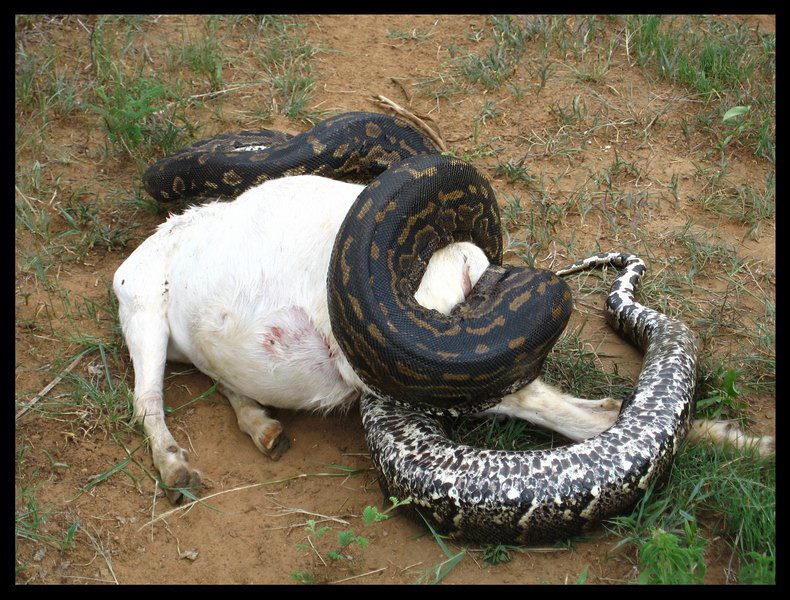
The African Rock Python (Python sebae) is one of Africa’s most feared snakes due to its size and occasional attacks on humans. Although these incidents are rare compared to other large predators like crocodiles or lions, reports of human fatalities caused by this massive constrictor do exist. The African Rock Python has been known to attack when it feels threatened or cornered; however, it usually avoids human contact if possible.
- Distribution: Sub-Saharan Africa from Senegal eastward through Ethiopia down into South Africa.
- Habitat: Grasslands near water sources such as rivers or swamps where they can easily ambush their prey.
- Diet: Mainly mammals, including rodents but also birds, reptiles, and even small crocodiles at times.
Amethystine Scrub Python: Heat-sensing pits aid in nighttime hunting
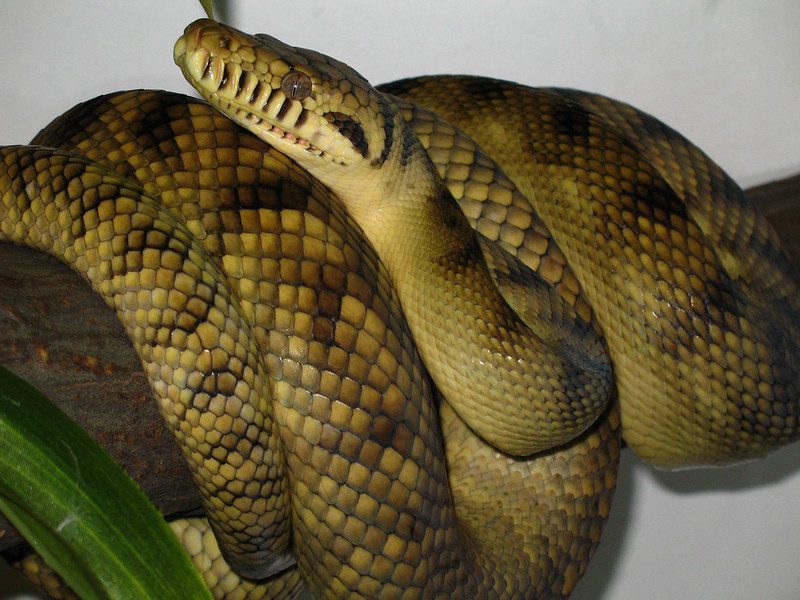
The Amethystine Scrub Python (Simalia amethistina,, formerly known as Morelia amethistina) is the largest snake species found in Australia and Papua New Guinea. These nocturnal hunters have heat-sensing pits located on their lower jaw, which allows them to detect the body heat of their prey during nighttime hunts. This adaptation makes them highly efficient predators in their natural habitat.
- Distribution: Northern Australia, Papua New Guinea, and Indonesia’s Maluku Islands.
- Habitat: Rainforests, woodlands, and grassy areas where they can easily camouflage themselves among vegetation.
- Diet: Mainly mammals, including rodents but also birds, reptiles, and even small crocodiles at times.
In both Africa and Australia, these giant snakes play a crucial role as apex predators within their ecosystems, keeping populations of smaller animals under control while providing food for other carnivores, such as eagles or leopards who may scavenge from python kills. As we continue to explore our planet’s diverse wildlife, it becomes increasingly important that we understand, respect, and protect these magnificent creatures, along with all life forms sharing this world with us.
The African and Australian giants are an impressive sight to behold, but the Green Anaconda is a whole different level of power. Its formidable might and surprise-attack aptitude render it one of the most dreaded predators in South America.
The Mighty Green Anaconda
As the heaviest snake in the world, the green anaconda is an awe-inspiring creature that can weigh up to 227 kilograms and reach lengths of 8.43 meters. Primarily found in South America’s tropical rainforests, these massive snakes are known for their incredible strength and ability to consume large prey such as deer, turtles, capybaras, and even jaguars.
South American Heavyweight Champion
The green anaconda holds the title of being not only the heaviest but also one of the longest snakes worldwide. Its size enables it to take down substantial prey with ease. The sheer power this snake possesses allows it to constrict its victims until they suffocate before swallowing them whole.
- Length: Up to 8.43 meters (27 feet)
- Weight: Up to 227 kilograms (500 pounds)
- Habitat: Tropical rainforests in South America
- Diet: Deer, turtles, capybaras, herons, lizards, jaguars, and other large animals
Ambush Predator with Immense Strength
The green anaconda is a master at ambush predation due primarily to its excellent camouflage abilities within dense vegetation along riverbanks or swamps, where it patiently waits for unsuspecting prey. Its heat-sensing pits on its snout allow it to detect the body heat of potential prey, even in complete darkness. Once a suitable victim is within reach, the anaconda strikes with lightning speed and wraps its powerful coils around the animal, constricting tighter with each breath until suffocation occurs.
In addition to their immense strength and size, green anacondas are also excellent swimmers. They can move through water at surprising speeds and have been known to hunt aquatic animals such as fish and caimans. This adaptability makes them one of nature’s most efficient predators.
Frequently Asked Questions Biggest Snakes Worldwide
What is the largest snake ever found in the world?
The largest snake ever discovered is the prehistoric Titanoboa, which lived around 60 million years ago. Fossil evidence suggests that this colossal predator reached lengths of up to 42 feet (12.8 meters) and weighed approximately 2,500 pounds (1,135 kilograms). Learn more about Titanoboa here.
How big is the biggest snake in the world right now?
Currently, the title for the longest snake goes to reticulated pythons. The longest recorded specimen measured at 25 feet and 2 inches (7.67 meters) long. However, green anacondas are considered heavier, with some specimens weighing over 550 pounds (250 kilograms). Discover more about these massive snakes here.
Conclusion
In conclusion, the biggest snakes worldwide are truly amazing creatures. From venomous giants to massive pythons and prehistoric titanoboa, these reptiles have been around for centuries. Rattlers in North America can reach up to 8 feet long, while other species from places like Africa and Australia, such as the green anaconda, may stretch out to over 30 ft. These impressive animals serve a vital role in their respective ecosystems and deserve our respect.
Discover the biggest snakes in the world and learn about their habitats, diets, behaviors, and more. Help protect these incredible creatures by taking action to preserve their natural environment today!









































